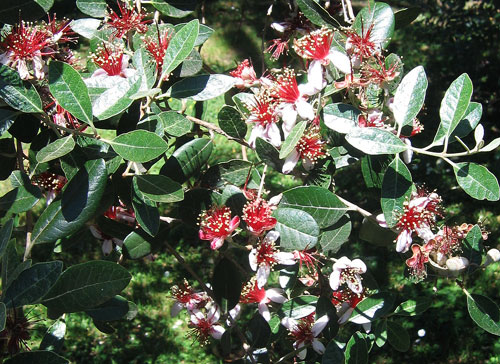| GreenGardeningCookingCuring.com | G
PAGE |
| Tour Our Destination Websites | Taxco-Today.com | Oaxaca-Today.com | Montserrat-Today Site |
| See our silver designs at Krika.com | Read our travel stories and other tales at Krika.com |
|
|
| Galingale See The "P" Page -- PALMS, Umbrella Palm | ||||
|
||||
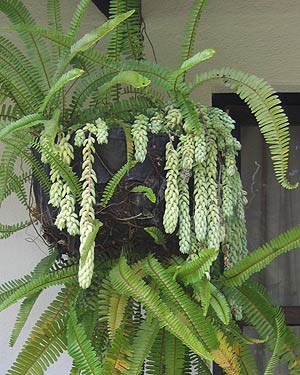 Surprisingly,
a tropical climate is the most difficult environment in which
I have ever had a garden. And, I have been gardening since I
was a youngster growing up in Rhode Island, a tiny coastal state
in New England, the most northeastern part of the United States.
As an adult I have had beautiful and very productive gardens
in Rhode Island, Washington, D.C., and in Taxco, Mexico. Surprisingly,
a tropical climate is the most difficult environment in which
I have ever had a garden. And, I have been gardening since I
was a youngster growing up in Rhode Island, a tiny coastal state
in New England, the most northeastern part of the United States.
As an adult I have had beautiful and very productive gardens
in Rhode Island, Washington, D.C., and in Taxco, Mexico.
Gardening on the Caribbean island of Montserrat proved to be my greatest challenge. Instead of being the garden of Eden I envisaged when we bought our property, it challenged everything I knew. It seems that every avid gardener arriving to live in Montserrat does so with the same enthusiasm and unbridled hope as I did; here it is sunny and warm year round and there are many months of rain -- what a garden I will have! |
||||
| When we bought our property in Montserrat in the West Indies several years ago, I fell in love with the overgrown garden, the views and the national park that lies behind the property. The house was comfortable and the pool was lovely, but the garden was not exactly as it appeared. In the garden, the first two inches or so of the soil was pure volcanic ash, a fine grained powdery cement-like material. Below that, we found about two inches of rock hard barren generic dirt and rocks and below that we found even harder clay. None of our familiar garden tools were up to the job of dealing with the ground so we turned to the local favorite, a mattock. The mattock redefines what you may think of as a "pick." I can barely lift it and by the time I've carried it to the garden I am exhausted and there the tool lies till tomorrow. With my over-riding gardening optimism and my husband's desire to make me happy, we dug out a fifteen by fifteen foot garden the first year and I began to enhance the soil -- making good dirt is one of my passions. We were in Montserrat hard at work for several years. Often when local farmers come by to see our gardens we would hear comments like, "Look at that fat soil." Fat soil is prized in Montserrat as the best place to grow vegetables. CARIBBEAN OR TROPICAL GARDENING HINTS Gardening
by the Moon New
moon to the Full moon Full
moon to the New moon New
Moon to the First Quarter First
Quarter to the Full Moon Full
Moon to the Last Quarter Last
Quarter Soil pH The sweetness (alkalinity) or acidity of your soil will affect the health and productivity of your garden plants. A pH on the sweet side is normally considered beneficial for most vegetables. Gardeners routinely apply agricultural lime to sweeten the soil before planting. In Montserrat there was no lime available so farmers used wood ashes or nothing at all. This had a decided impact on the quality and quantity of vegetables that were produced there. The pH scale runs from 0 to 14 with 7 being just about neutral. Numbers above 7 are alkaline and below 7 are acid. If you are in a similar situation with no access to lime, use the ashes from firewood. Spread them as thickly as you can on the garden area and mix them into the soil. Then water it well and do so for three days or so before planting. Summer vs Winter Planting in the Tropics One of the most important things I finally learned is that the most successful vegetable gardens in the Caribbean are planted to be harvested in the winter. In the Caribbean, summer is a time for letting the garden rest -- with very few exceptions. Mung beans and yellow/orange sweet potatoes do well, as does okra (ick). Mexican hot peppers of all kinds do well too. I'd love to hear if you have had real success planting other crops in the hot summer, tips I can pass along to other gardeners like us. Sun Versus Shade Planting In our garden area we didn't have too many places receiving full sun all day which proved a blessing. It was my experience that gardening in areas with morning or afternoon sun was best followed by areas of dappled sunlight and finally in areas with only bright shade. Tropical sun burns in a way not experienced in the north even on the hottest days so you can adjust your plantings so they receive light, but are not 'cooked' Watering If you live in a tropical environment that has an extended dry season or uneven amounts of rainfall, you will most likely be forced to drag out the hoses. I found it best to water only during the very early morning in areas receiving morning sun. I was then able to move the hoses to areas receiving afternoon sun and finally to areas of bright shade. Watering plants in direct sunlight simply burns them so get off to an early start to your day. Text ©KO 2008 and photograph ©GrenGardeningCookingCuring.com 2010/2018 |
||||
See also India Carnation on the "I" Page for what is called a gardenia in Montserrat. |
||||
GARLIC |
||||
| **Garlic Allium
sativum L. Garlic has been widely promoted for years as THE food that will cure whatever ails you. It was perhaps the first "super food" to be taken on by advertising and public relations firms hired by agriculture companies growing garlic. The industry was centered in the US so that is where their money paid off when garlic gained wide popularity. Many people believed the 'hype' and are now eating it in impressive quantities. Please remember that the smell of garlic in food is not so aromatic in sweat. If you will be flying on a commercial flight especially outside of the US, be courteous and cut down on your garlic consumption three days before your flight. Benefits: As I've said above, if you have any ailment, even cancer, garlic is said to cure it. And, if you believe that, I have a bridge to sell you too. Many years ago I read that garlic would rid dogs of intestinal parasites which sounded great. I asked the veterinarian who took care of my two Irish Setters what he thought. His response was very simple. If you can get them to eat a bushel of garlic each in one day, it may work. Enough said for that "cure." From: Central or South Asia, or maybe even southwestern Siberia Planting and Growth: Buy a nice looking head of garlic and let it age naturally on the shelf outside of the sun until it begins to sprout. Break apart the head into its cloves and fill an 8" wide 6" deep pot with good soil. Push the individual cloves into the soil until only the head remains visible. Water and place in the sun. With regular sun and water you’ll not only have lovely plants, you’ll have leaves that you can add to salads and eventually new heads of garlic. This method worked fine when I was planting in pots, but when I turned to planting in the garden I had very disappointing results. This is an alternate planting method I found. Take a fresh head of garlic and break it apart into cloves. Soak them for two hours in water with a heaping tablespoon of bicarbonate of soda which is said to neutralize fungus. Drain the water and remove the skins. Next soak the cloves in alcohol a few minutes and plant them immediately about 3" deep in soil. Text ©GreenGardeningCookingCuring.com 2013/2018 |
||||
 Garlic
Chives Allium tuberosum Garlic
Chives Allium tuberosumBenefits: The onion like leaves are edible and the autumn blossoms are very pretty. From: China Photographed: In the Thuya Garden, Mt. Desert Island, Maine, 2013. Planting and Care: This perennial plant will do well in full sun or in a sunny place with some shade. Give it an average amount of rainfall or watering for your area. Text and Photograph ©GreenGardeningCookingCuring.com 2018 |
||||
| Wild
Garlic Tulbaghia violacea From tuberous roots, the thin strap shaped leaves of wild garlic will grow to be about twenty inches tall while the flower stalk will grow to be just a bit taller than the leaves. Benefits: Aside from its edible leaves and flowers, it is believed that its strong smell of garlic when the plant is brushed or when the leaves are crushed and used as a rub will repel insects such as fleas and mosquitoes. In Africa, wild garlic is believed to have all of the beneficial qualities for human health that regular garlic is known for throughout the world. It is even believed to be a snake repellent and said to be planted around Zulu homes for that reason. From: Southern Africa Photographed: None yet, but I'm always looking. Planting and Growth: Wild garlic grows quickly and is ideal for enlivening the sunny, hot, dry, difficult areas in a tropical garden. They will grow and bloom, but if you can give them a bit of extra water they will really shine. The pink to lilac flower heads will bloom for almost four months. Ideally wild garlic will thrive in a well composted and moist soil in a sunny or semi shady area of your garden. Text ©KO 2008 and ©GreenGardeningCookingCuring.com 2019 |
||||
White
or Pink Gaura, Lindheimer's
Bee Blossom, Lindheimer's Clockweed,
Indian Feather Gaura lindheimeri This plant was one of my many mysteries and it was graciously solved by these two folks at the same time, with my great appreciation, http://www.kwiaht.org/kwiaht.htm "Kwiáht is a nonprofit conservation biology laboratory in and for the San Juan Islands of Washington State." C. Howell Ellerman from California |
||||
  |
||||
Flower Mystery solved by Ursula G. living in Southern Germany |
||||
| Geiger Tree See The "C" Page -- Cordia Tree | ||||
|
||||
|
||||
Geranium
'Rozanne Cranebill' |
||||
|
||||
|
||||
|
||||
|
||||
|
||||
| **Geranium Tree See The "C" Page -- Cordia Tree | ||||
 German
Ivy, Water Ivy, Parlor Ivy Senecio mikanioides,
Delairea odorata German
Ivy, Water Ivy, Parlor Ivy Senecio mikanioides,
Delairea odorataFrom: South Africa Benefits: This vine's pretty yellow flowers are butterfly and hummingbird attractants. Photographed: On a wall by the side of the road in the town of Panajachel on Lake Atitlan in Guatemala in May of 2010. Planting and Care: This pretty and quick growing vine will be happy in full sun or semi shade with a reasonable amount of water. Plant it either as a ground cover or to grace a low stone wall. Text and Photograph ©KO 2010 and ©GreenGardeningCookingCuring.com 2018 |
||||
| Giant Bat Face Cuphea See the "T" Page -- TORPEDO CUPHEA | ||||
| Giant Pelican Flower See the "D" Page -- DUTCHMAN'S PIPE | ||||
| **Giant Salvia See the "J" Page -- JAVA GLORYBOWER | ||||
| Giant Yellow Justicia See the "B" Page -- BRAZILIAN PLUME FLOWER (YELLOW) | ||||
| **Giant Yucca See The "Y" Page YUCCA -- Spineless Yucca | ||||
**False
Cardamon Ginger, Dwarf Cardamon Alpinia
nutans |
||||
**Common
Ginger, Cooking Ginger, Edible Ginger Zingiber
officinale Recipe for Ginger Tea: |
||||
| **Kahili
Ginger, Kahili Garland Lily, Hedychium gardnerianum We found this plant in an area of our Montserrat property that had long ago gone back to being a truly untamed tropical garden. The kahili looked much like a spathiphyllum plant I'd had years ago so I transplanted it to see what it would do. Not much was the answer for a few years and then suddenly it flowered with very muted colors and very unflower like flowers that did in the end have a strange appeal. Benefits: Kahili ginger may be beneficial in the treatment of cancer. From: The eastern Himalayas in northern India, Nepal and Bhutan Photographed: In our shady terrace garden at our former home in Montserrat. Planting and Care: This type of ginger like so many of the others seems to prefer a semi shady area with bright light and routine rainfall or watering. It should be planted where its foliage will be the highlight rather than its infrequent and unusual flowers. Text and Photographs ©Krika.com 2008 and ©GreenGardeningCookingCuring.com 2018 |
||||
|
||||
|
||||
|
||||
Photographed: As part of a floral arrangement in Panajachel, Guatemala.
|
||||
|
||||
| **Red
Button Ginger, Scarlet Spiral Flag, Dwarf Cone Ginger,
Red Cane, Panamanian Candle Ginger, Dwarf French Kiss Costus
woodsonii This is a lovely easy to grow plant in the ginger family. It has bright red knobby sorts of flowers, almost like tight small pinecones. Benefits: Red Button ginger appears to have significant medicinal benefits. It has been used to treat high blood pressure, bladder problem, ear infections and even fever and coughs. From: Tropical areas from Nicaragua to Columbia Planting and Care: This is a perennial which will grow to be from 3 to 6 feet tall. Red Button flowers around the year and does best in sun or in a semi shady area with routine rainfall or watering though it will tolerate some dry periods. It doesn't seem at all difficult to grow or even to thrive and it makes an attractive and distinctive backdrop for other plants. I planted mine where it would receive almost full sun, but not wanting to risk sunburn I'd recommend a place in the garden with morning or late afternoon sun. Text and Photographs ©Krika.com 2009/ 2010 and ©GreenGardeningCookingCuring.com 2014/2018 |
||||
|
||||
|
||||
| Red
Ginger Lily Alpinia purpurata Benefits: The Alpinia purpurata is said to have many and diverse health benefits. From: Malaysia Planting and Care: Like many varieties of ginger, it likes a moist soil with lots of humidity. It will do best in a bright shady area of the garden. It is not tolerant of freezing conditions. Photographed: At the Hotel Atitlan botanical garden on Lake Atitlan in Guatemala. Text and Photographs ©KO 2010 and ©GreenGardeningCookingCuring.com 2018 |
||||
|
||||
| Shampoo Ginger See Pine Cone Ginger Above | ||||
 **Shell
ginger Alpinia zerumbet **Shell
ginger Alpinia zerumbetThis large variety of ginger will grow to about nine feet when planted in rich loamy soil in its preferred partial shade and given adequate water. It is a tough plant; ours in Montserrat survived a drought with no watering as we were away for several months. Its sturdiness is wonderful, but its flowers are the real reason to have it in your garden. They are lovely! Benefits: Shell ginger is believed to have many and varied medicinal uses ranging from fever reduction to reducing muscle spasms, intestinal gas, and swelling. Always check with your physician before using an herbal medicine as many can have adverse effects. From: East Asia Photographed: To the left at the Hotel Atitlan at Lake Atitlan in Guatemala. Below on the left in our shady terrace garden at our former home in Montserrat and on the right at the Hotel Magdelena in Tobago in 2018. Planting and care: Shell ginger loves water and will do well in a sunny to semi shady setting flowering usually in the spring. It should be fertilized about twice a year. Text and Photographs ©KO 2007/2010 and ©GreenGardeningCookingCuring.com 2013/2018 |
||||
|
||||
| **Spiral
Ginger, Crape Ginger, Crepe Ginger Costus speciosus This is a very lovely plant with beautiful flowers and it lived happily in our shaded terrace garden in Montserrat. Then one year we returned from our travels and it was gone, but now growing across the street in our neighbors garden. Benefits: As with other ginger family plants, spiral ginger has a wide range of health benefits. From: Tropical Asia Photographed: Below on the left In our shady terrace garden at our former home in Montserrat and on the right in Crown Point, Tobago, in 2017. Planting and Care: This lovely spiral stemmed ginger well situated will grow to about six feet tall and will have lots of lovely flowers and the foliage all by itself is very attractive. It will grow best in a bright semi shady area with routine rainfall or watering. If you happen to live in Montserrat, guard it carefully as these 'good' Christians steal with abandon. Text and Photograph ©KO 2007 and ©GreenGardeningCookingCuring.com 2018 |
||||
|
||||
 Torch
Ginger, Tulip Torch Ginger, Philippine Wax Flowers Etlingera
elatior or synonyms Phaeomeria speciosa, Nicolaia
elatior, Phaeomeria magnifica, Nicolaia speciosa, Alpinia elatior,
Alpinia magnifica Torch
Ginger, Tulip Torch Ginger, Philippine Wax Flowers Etlingera
elatior or synonyms Phaeomeria speciosa, Nicolaia
elatior, Phaeomeria magnifica, Nicolaia speciosa, Alpinia elatior,
Alpinia magnificaThis is one of the creepier gingers which in almost all phases of flowering appears to be a plant from outer space, something dropped here on earth by accident or with a sinister plan. Of course this makes me want one for our garden as soon as I can get seeds or a seedling. Benefits: Aside from being used in food preparations in several countries, torch ginger is said also to be of great benefit in healing. From: Indonesia and Thailand Photographed: In the Botanical Garden at the Hotel Atitlan on Lake Atitlan in Guatemala. Planting and Growth: While the leaves will shoot up to 14 feet, the flower stalks will be only 3 or 4 feet tall. They emerge first looking almost like a thin tulip on the top of a tall stem and then the real flower flows forth. The plant is said to prefer full sun or bright light, but all of the photographs here were taken in relatively deep shade though the tops of the tall leaf shoots were all in bright sun. The plants do seem to require lots of moisture and like almost all plants in the ginger family they do not like to be in a windy situation. Text and Photographs ©KO 2010 and ©GreenGardeningCookingCuring.com 2018 |
||||
|
||||
|
||||
|
||||
| Tulip Torch See Torch Ginger Above | ||||
 Variegated
Ginger Alpinia Zerumbet Variegata Variegated
Ginger Alpinia Zerumbet VariegataAs with almost all variegated foliage plants, variegated ginger adds a bit of pizzazz to a shady garden. Benefits: This is not an edible form of ginger. From: East Asia Photographed: At the Hotel Atitlan Botanical Garden on Lake Atitlan in Guatemala. Planting and Care: Variegated ginger grows best in bright shady areas of the garden although it will make do with partial shade and morning or late afternoon sun. It likes fertile moist soil and frequent rainfall or watering Text and Photograph ©KO 2010 and ©GreenGardeningCookingCuring.com 2018 |
||||
 Variegated
Spiral Ginger, Crepe Ginger, Crape Ginger, Wild Ginger, Malay
Ginger Costus arabicus 'Variegatus' or
Costus speciosus var. variegatus Variegated
Spiral Ginger, Crepe Ginger, Crape Ginger, Wild Ginger, Malay
Ginger Costus arabicus 'Variegatus' or
Costus speciosus var. variegatusThis is a plant I would have for its foliage as its white flowers are relatively small. It will certainly do a good job of dressing up a shady area of your tropical garden. Benefits: This small ginger plant has many health benefits and, as well, it is used in cooking. From: Tropical Asia Photographed: In the Jardin Botanique in Tahiti in 2013. Planting and Care: This ginger is smaller than many others, growing to be only about 3 feet in height. It prefers a bright shady area of the garden, but can handle some direct sun. They like to be well watered, but not drenched, and of course a humid environment makes them pretty happy. Text and Photograph ©GreenGardeningCookingCuring.com 2013/2018 |
||||
|
||||
 White
Butterfly Ginger Lily Hedychium
coronarium White
Butterfly Ginger Lily Hedychium
coronariumBenefits: Hedychium is one of the plants used in Chinese medicine. From: SE Asia, southern China, the Himalayas and Madagascar Photographed: In the Hotel Atitlan Botanical Garden on Lake Atitlan in Guatemala. Planting and Care: A bright shady place in the garden seems almost essential since this ginger will dry out and suffer terribly in the sun. A rich moist soil along with the shade should do the trick and you will have lovely flowers like these. Text and Photograph ©KO and ©GreenGardeningCookingCuring.com 2018 |
||||
| Yellow
Butterfly Ginger, Nardo Ginger Lily Hedychium
flavum Benefits: This ginger is used in various ways in Chinese medicine. From: The Himalayas Photographed: In the Hotel Atitlan Botanical Garden on Lake Atitlan in Guatemala. Planting and Care: Unlike most gingers the one is said to need full sun to flower well. I found it growing in the same bright shady area as the two Hedychium coronariums above so I suspect the plant is a little flexible with light conditions. It also likes a fertile, humusy moist soil an grow to 5-7 feet Text and Photographs ©KO 2010 and ©GreenGardeningCookingCuring.com 2018 |
||||
|
||||
|
||||
GLOBE
AMARANTH |
||||
**Globe
Amaranth, Bachelor Button Gomphrena
globosa syn. Globe amaranth |
||||
|
||||
|
||||
|
||||
|
||||
| Glue Berries Tree See The "C" Page CLAMMY CHERRY TREE | ||||
| **Goat
Horn Tree Goat horn is a meddlesome tree that resists elimination; cut it back and it simply grows again. It has sharp thorns and seems to find ideal growing conditions right within the root base of some of your favorite plants and trees. Its only saving grace apparently is that once mature it can be used in making charcoal. Text © KO 2007 |
||||
| **Goatweed See The "P" Page -- POPPIES - Mexican Poppy | ||||
| **Golden
Apple Tree, Japanese bitter orange, Stone Apple or Wood Apple,
Bengal Quince
Aegle marmelos The golden apple belongs in the citrus family. Its fruit is highly prized by those that know it. We received and planted a seedling and thought it would be a few years before we would know if it would become one of our favorites. It got off to a good start, but sadly we sold our home before we grew to know it well. Benefits: Sweet and tangy fruits that may be as large as a grapefruit. They are said to have a lovely smell. It is also said to many curative qualities, but be very careful with it because it is known to cause liver damage. From: India and Southeast Asia Photographed: On the left below just under our shady terrace garden at our former home in Montserrat and on the right in Bon Accord, Tobago, in 2018. Planting and Care: This is a tree of modest size slowly growing to be about 50 feet in height. Once planted in full sun, it is uncomplaining about the type of soil it lives in or its pH. It likes soil that is moist either by rainfall or by watering. It does not grow well in windy conditions. Text and Photograph ©GreenGardeningCookingCuring.com 2013/2018 |
||||
|
||||
 Golden
Ear Drop, Pigeon Berry, Skyflower (1) Duranta
erecta Linn. Golden
Ear Drop, Pigeon Berry, Skyflower (1) Duranta
erecta Linn.With its beautiful purple flower this plant is inaptly named. It can reach a height of 20 feet at which point it will probably have developed the thorns missing on younger plants. Benefits: Golden Dew Drop will attract butterflies and hummingbirds. Both are immune to its toxins. From: Tropical and subtropical areas of Mexico, South America and the Caribbean Photographed: In the Royal Botanic Garden in Sydney, Australia, in 2013. Planting and Care: For the best results plant this shrub in moist, fertile, well-drained soils in full sun. It is tolerant of a range of soil types and it will accept some shade though the flowers won't be as prolific. Warning: This plant is highly poisonous to humans and pets. Text ©KO 2008 and text and photograph ©GreenGardeningCookingCuring.com 2018 |
||||
Golden
Dew Drop Duranta
plumieri Jacq. |
||||
|
||||
Golden
Plume Schaueria calycotricha, Schaueria flavicoma,
Justicia flavicoma Flower Mystery solved by Ursula G. living in Southern Germany |
||||
|
||||
| **Gold
Vein Plant, Sanchezia, Fire Fingers, Zebra Plant, Yellow Sanchezia,
Shrubby Whitevein, Sanchezia
speciosa J. Leonard and Sanchezia nobilis This is a colorful bush as you can see with deep green leaves veined with yellow verging on white growing on reddish/purple stems. And, it also flowers with bright yellow blossoms that are hummingbird attractants. That's a lot of bang for a bush! Benefits: This is a butterfly and hummingbird attractant. Studies seems to suggest the gold vein plant may have medicinal uses for a range of relatively serious diseases. From: Peru and Ecuador or Northern South America in general. Photographed: At the Hotel Atitlan on Lake Atitlan in Guatemala. Planting and Care: This plant is native to rainforest environments so do your best to duplicate that type of environment. Planted in full sun or in semi shade in a moist environment the gold vein plant will do its best reaching a height of from 6 to 8 feet or maybe more and spreading to as much as 6 feet. It is not frost hardy, but it is tolerant of the salt in a seaside environment. Text & Photographs ©GreenGardeningCookingCuring.com 2013/2018 |
||||
|
||||
| **Gooseberry
Tree, Malay Gooseberry, Tahitian Gooseberry, Country Gooseberry,
Star Gooseberry, Starberry, West India Gooseberry Phyllanthus
acidus SKEELS and Phyllanthus
distichus Growing to thirty feet or more given the moist soil it prefers, the gooseberry is a dense tree that seems visually busy in its appearance. It has small leaves growing on soft extended stems, fruits that seem to arise from everywhere, and bark that varies from smooth to spiny. Benefits: In Montserrat the fruit is used to make wine. Its sour yellow fruits turn red when cooked in sugar water making a very nice drink. The tree is widespread around the world and many uses have been found for its fruits and for its leaves. It is also believed to have hefty medicinal qualities. From: Southern Asia, South and Central America, the Caribbean, but it may have originally been from Madagascar Photographed: Below our terrace garden at our former home in Montserrat. Planting and Care: The gooseberry likes moist tropical soil and lots of sun. It produces most of its fruits all at once during the winter months. Problems: In bad years, like 2007, this lovely tree was very vulnerable to caterpillars. They ate every leaf twice that year. We were advised to consider introducing a systemic insecticide, but chose to lose the tree before introducing yet more poison into the already very toxified environment on that small island. In the end it looked like the tree was going to survive without the poison so bravo for us. Text & Photographs ©GreenGardeningCookingCuring.com 2013/2018 |
||||
|
||||
 Gourds Cucurbitaceae family Gourds Cucurbitaceae family Benefits: These vining squash like fruits are dried and used as decorative pieces in many a home across the US. At one time in history they were used as storage vessels. From: North America Photographed: In the Blithewold Garden in Bristol, Rhode Island 2013. Planting and Care: Think of this as a winter squash. Treat it just the same and it will flourish. Text and Photograph ©GreenGardeningCookingCuring.com 2013/2018 |
||||
|
||||
|
||||
A
Southern Sicilian Vineyard in Spring
|
||||
Photographed: In Santiago Chile in 2019  |
||||
 **Grape
Ivy, Oak Leaf Ivy Cissus rhombifolia Ellen
Danica **Grape
Ivy, Oak Leaf Ivy Cissus rhombifolia Ellen
DanicaI loved the grape ivy I had growing in a hanging pot my apartment in New England many years ago. It was huge (2 feet wide and three feet long). Fortunately I had equally huge windows and this filled one of them. Grape ivy more resembles a grape vine. The ivy pictured in the photograph is an oakleaf ivy with leaves very much resembling oak leaves. Benefits: I didn't find anything other than its splendid greenery. From: Tropical America Photographed: In the Wellington Botanic Garden in Wellington, New Zealand, in 2013. Planting and Care: This softer version of a vine loves to grow in a hanging basket in a bright area of the garden free of mid day and afternoon sun. It is an ordinary plant needing ordinary amounts of water. It is not frost hardy so it will have to find a place in the house if you're growing it in an area that is not frost free. Text and Photograph ©GreenGardeningCookingCuring.com 2014/2018 |
||||
Desert
Plains Fountain Grass Pennisetum alopecuroides |
||||
|
||||
| **Fountain
Grass, Napier Grass, Cane Grass, Elephant Grass Pennisetum
purpureum 'Princess Caroline' This delicate purple hued grass grows to be up to three feet tall with feathery fronds of seeds topping the foliage. We used this grass as a foundation cover for part of our home in Montserrat. It was perfect. It grew heartily in the full hot sun of the Caribbean and didn't ask for too much attention. I remember once a year cutting it down to about 6" as if mowing. That little care ranked it as one of the best plants in the garden. Benefits: From: Originating in Africa and/or Afghanistan, fountain grass is now widely distributed in the world. Planting and Care: Its ability grow in just about any soil with good drainage and its ability to thrive in full sun on short water supplies makes this an ideal decorative grass. Landscaping ideas: Fountain grass makes a beautiful soft foundation cover for any home or small office building. It requires almost no care and thrives in terrible conditions -- full sun in tropical climates with low water requirements. Text ©KO 2008 and Photographs ©GreenGardeningCookingCuring.com 2018 |
||||
|
||||
Japanese
Forest Grass, Japanese Temple Grass, Golden Japanese Forest Grass Hakonechloa
macra With my appreciation, this mystery grass was identified by Peter from Auckland, New Zealand. |
||||
  Photographed: On
the right, at the Roger Williams Park Botanical Center in Rhode
Island
in 2014. Photographed: On
the right, at the Roger Williams Park Botanical Center in Rhode
Island
in 2014. |
||||
 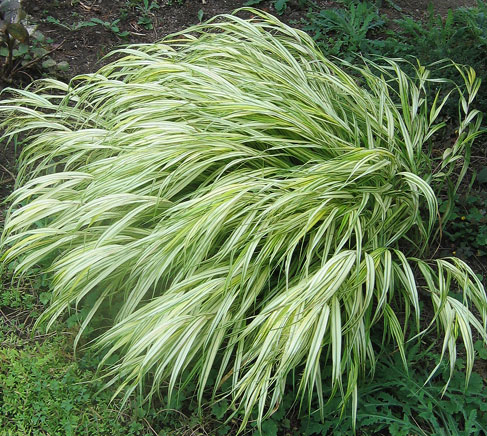 |
||||
| Japanese
Pampas Grass, Pampas Grass Miscanthus sinensis This beautiful perennial grass will please you greatly as a background for flowering annuals. It will grow to be at best 7 feet tall making almost a wall between your garden and whatever is behind it. Benefits: From: Temperate areas of Eastern Asia Photographed: As noted. Planting and Care: Text and Photograph ©GreenGardeningCookingCuring.com 2015/2018 |
||||
|
||||
|
||||
| **Lawn Grass See The "Z" Page -- ZOIZIER | ||||
 Little
Bluestem, Bunch Grass, Beard Grass, Povertygrass, Broom Bluestem Schizachyrium
scoparium Little
Bluestem, Bunch Grass, Beard Grass, Povertygrass, Broom Bluestem Schizachyrium
scopariumThis is a lovely three foot tall perennial grass native to North America. Probably settlers heading west saw a lot of it on the way. I don't know if you can see it in the photograph on the right, but this grass has alternating lavender and blue green stems which are very pretty. One of the characteristics of this grass is its color changes as the seasons flow by. Benefits: Provides perfect habitat for some butterflies. From: North American prairie Photographed: In the Coastal Maine Botanical Gardens, Boothbay, Maine, 2013. Planting and Care: This is a survivor grass which does best in sunny places with well drained soil. Text and Photograph ©GreenGardeningCookingCuring.com 2013/2018 |
||||
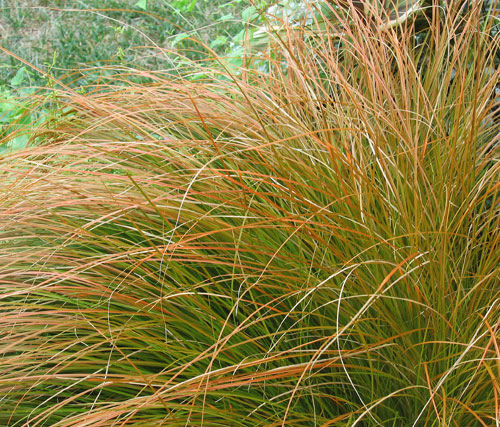 Orange
New Zealand Sedge, New Zealand Hairy Sedge Carex
testacea Orange
New Zealand Sedge, New Zealand Hairy Sedge Carex
testaceaI found this plant attractive in the same way that I find ornamental grasses appealing. It is relaxed, its coloring draws my eyes and I suspect it is easy to care for. Benefits: From: New Zealand Photographed: In the Blithewold Garden in Bristol, Rhode Island, in 2013. Planting and Care: Orange New Zealand sedge shows off its beautiful colors especially well when planted in full sun. It likes a mildly acidic or neutral moist rich soil. It is not considered winter hardy where soil actually freezes. Text and Photograph ©GreenGardeningCookingCuring.com 2013/2018 |
||||
| Great Morinda See The "N" Page -- NONI | ||||
| Greek Akanthos See The "B" Page -- BEAR'S BREACH | ||||
| **Greek Oregano See The "O" Page -- OREGANO | ||||
| **Green Beans See The "B" Page -- BEANS | ||||
| Green Peas See The "P" Page -- PEAS | ||||
| **Green Peppers See The "P" Page -- PEPPERS | ||||
Green
Tea Recommended Website: http://www.inthesetimes.com/issue/24/19/whittelsey2419.html Text ©KO 2010 and GreenGardeningCookingCuring.com 2014/2018 |
||||
| **Groundnuts See The "P" Page -- PEANUTS | ||||
| **Ground Orchid See The "O" Page -- ORCHIDS | ||||
**Guava
Tree Psidium
guajava L. |
||||
|
With my appreciation, this mystery tree was identified by Peter from Auckland, New Zealand. |
||||
|
||||
| **Gum
Tree, Tourist Tree, Copperwood, Turpentine Tree Bursera
simaruba This is a fast growing tree that can be very attractive, but it will need to have some control or your property will soon be overrun with them. It was called a gum until the last couple of decades when tourists to the Caribbean made toast of themselves on the beaches. Their red and peeling skin reminded locals of the gum tree hence its new name. Benefits: 1. In Montserrat, gum tree bark is used as an antibiotic. Peel the bark and let it dry. Apply the dried bark to a wound and watch it heal. 2. Gum tree branches make great fence posts in the Caribbean where dead wood is so often attacked by termites. Simply stick a gum tree branch in the ground where you wish to have a fence post. Tie it to your fencing material, sit back and watch. Not only will you have a very secure fence post, you will have a tree! And the best news is that the gum tree is relatively unattractive to the plentiful and voracious Caribbean termites. From: Tropical areas of the Americas from Florida to Brazil Photographed: Planting and Growth: The gum will grow nicely in full sun or semi shade and it will handle dry conditions if it has to. The bark and trunk of the gum tree are very soft and easy to cut; unfortunately the roots are tenacious so be sure you want one before you plant it. Text ©KO 2008/2010 |
||||
| Guppy Plant See GOLD FISH Above on this Page | ||||
|


 **Gazania,
Treasure Flower Gazania rigens "Christopher
Lloyd"
**Gazania,
Treasure Flower Gazania rigens "Christopher
Lloyd" Geranium Pelargonium
sp.
Geranium Pelargonium
sp.
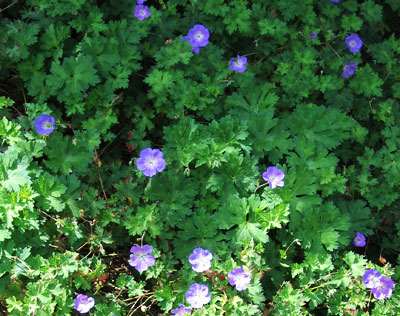

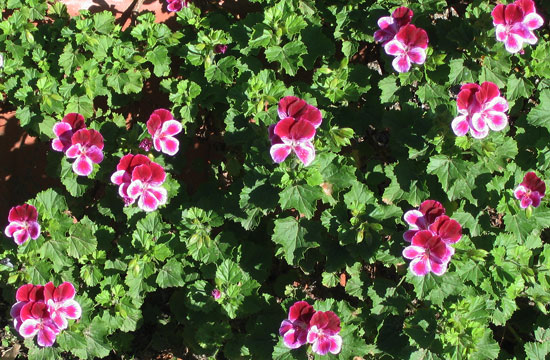




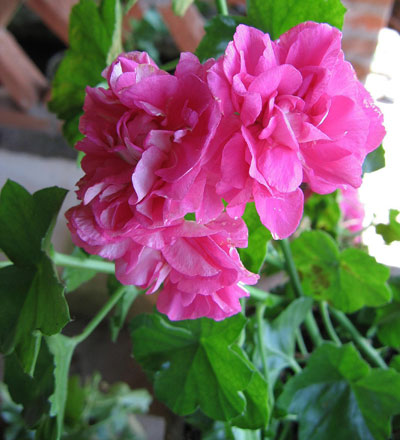




 Pine
Cone Ginger, Shampoo Ginger, Golden Shampoo Ginger, Bitter
Ginger Zingiber
zerumbet
Pine
Cone Ginger, Shampoo Ginger, Golden Shampoo Ginger, Bitter
Ginger Zingiber
zerumbet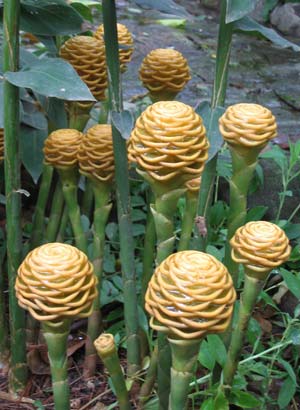


 Pink
Ginger Lily, Ostrich Plume Alpinia purpurata
Pink
Ginger Lily, Ostrich Plume Alpinia purpurata







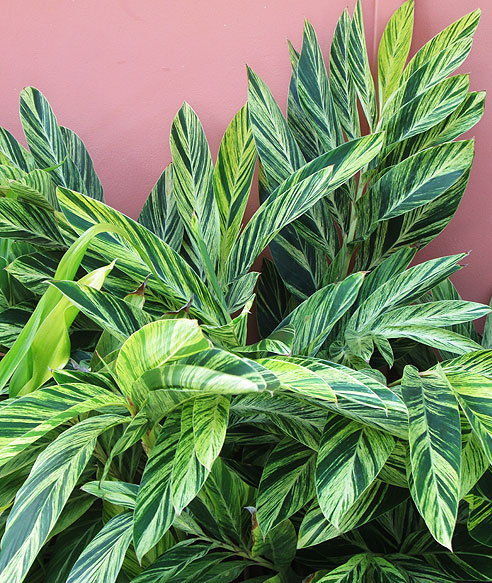

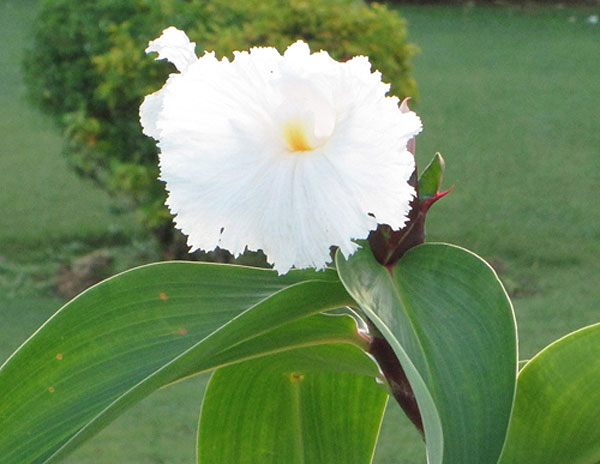



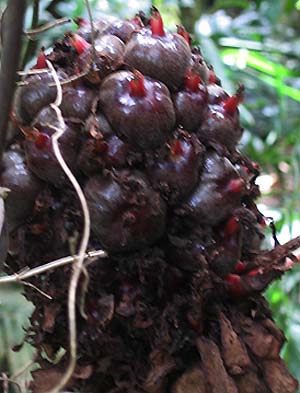
























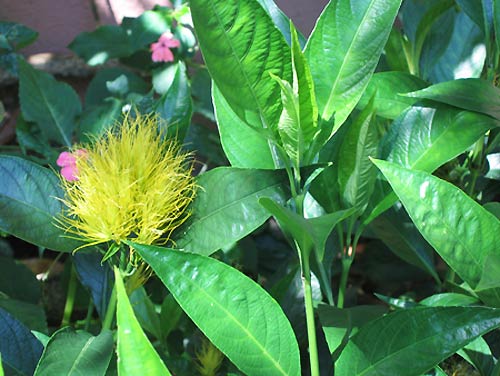













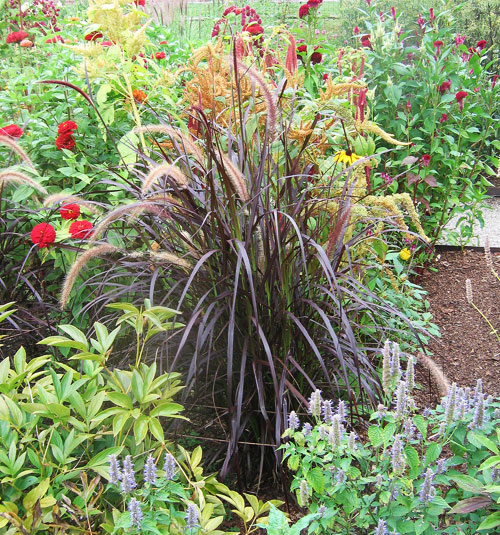





 Pineapple
Guava Feijoa sellowiana syn. Acca sellowiana
Pineapple
Guava Feijoa sellowiana syn. Acca sellowiana